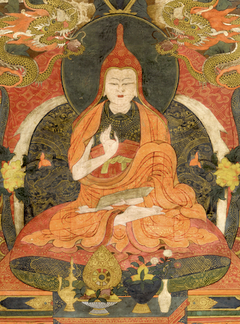The Essence of Mind
English | Español | Français | 中文 | བོད་ཡིག
The Essence of Mind
by Mipham Rinpoche
Namo Guru Mañjuśrīye!
The actual nature of things is inconceivable and inexpressible. Yet, for those fortunate individuals who seek to penetrate the profound meaning of dharmatā, I shall here offer a few words by way of illustration.
What we call “essence of mind” is the actual face of unconditioned pure awareness, which is recognized through receiving the guru's blessings and instructions. If you wonder what this is like, it is empty in essence, beyond conceptual reference; it is cognizant by nature, spontaneously present; and it is all-pervasive and unobstructed in its compassionate energy. This is the rigpa in which the three kāyas are inseparable.
It is therefore as the vidyādhara Garab Dorje said in his Final Testament:
This rigpa, which has no concrete existence as anything at all,
Is completely unobstructed in the arising of its self-appearances.
To summarize: the actual nature of mind—the way it has always been, in and of itself—is this innate pure awareness that is unfabricated and unrestricted.
When this is explained in negative terms:
- It is not something to be apprehended;
- Nor is it a non-existent void;
- It is not some combination of these two,
- Nor is it a third option that is neither.
This is the view of the absence of any identifiable existence, the fact that it cannot be conceptualised in any way by thinking, “It is like this.”
When explained in more positive, experiential terms, it is said to be glaringly empty, lucidly clear, vividly pure, perfectly even, expansively open, and so on.
To illustrate this using examples: without limit or centre, it is like space; in its unlimited clarity, it is like sunlight flooding the sky; without clear inside and outside, it is like a crystal ball; in its freedom from clinging and attachment, it is like the traces of a bird in flight; and neither arising nor ceasing, it is like the sky.
To dispel any doubts or misunderstandings that might arise from this instruction, it is described as the great clarity that is beyond partiality, the great emptiness of freedom from conceptual reference, the great union that cannot be separated, and so on.
In terms of its meaning, as it cannot be pointed out by words, it is inexpressible; as it cannot be known with ordinary modes of consciousness, it is inconceivable; and as it is does not fall into any extreme, it is the great freedom from elaboration. In the end, it is beyond all expressions, such as: it is all and everything, it is not all, everything lies within it, or does not, and so on. It remains an individual experience of self-knowing awareness.
The names used to illustrate it are 'primordial purity' (ka dag) and 'spontaneous presence' (lhun grub), and, when summarizing: 'the single, all-encompassing sphere of naturally arising wisdom' (rang byung ye shes thig le nyag gcig).
As it is the pinnacle of all in terms of the qualities it possesses, it is also the transcendent perfection of wisdom (prajñāpāramitā) and so on.
Symbolically, it can be revealed by means of the sun, or a magnifying glass, a crystal ball, or a finger pointing into space, and so forth.
When you have a precious jewel in your own hand,
Even if others should discard them, why be angry?
Without losing your connection to these instructions,
The pinnacle of Dharma, and your own good fortune,
Even if others should criticize them, why be angry?
By Mipham.
| Translated by Adam Pearcey, 2016, with the kind assistance of Alak Zenkar Rinpoche.
Bibliography
Tibetan Edition
mi pham. "sems kyi ngo bo." In mi pham gsung 'bum. 32 vols. Chengdu: Gangs can rig gzhung dpe rnying myur skyobs lhan tshogs, 2007. Vol. 32: 368–370
Secondary Sources
Pearcey, Adam. Beyond the Ordinary Mind: Dzogchen, Rimé, and the Path of Perfect Wisdom. Boulder: Snow Lion, 2018.
Version: 1.2-20220421
